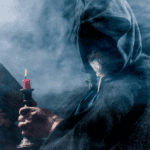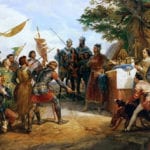 Crime
Crime  Crime
Crime  Technology
Technology 10 Hilariously Over-Engineered Solutions to Simple Problems
 Miscellaneous
Miscellaneous 10 Ironic News Stories Straight out of an Alanis Morissette Song
 Politics
Politics 10 Lesser-Known Far-Right Groups of the 21st Century
 History
History Ten Revealing Facts about Daily Domestic Life in the Old West
 Weird Stuff
Weird Stuff 10 Everyday Products Surprisingly Made by Inmates
 Movies and TV
Movies and TV 10 Actors Dragged out of Retirement for One Key Role
 Creepy
Creepy 10 Lesser-Known Shapeshifter Legends from Around the World
 Animals
Animals 10 Amazing Animal Tales from the Ancient World
 Gaming
Gaming 10 Game Characters Everyone Hated Playing
 Crime
Crime 10 Terrifying Serial Killers from Centuries Ago
 Technology
Technology 10 Hilariously Over-Engineered Solutions to Simple Problems
 Miscellaneous
Miscellaneous 10 Ironic News Stories Straight out of an Alanis Morissette Song
Who's Behind Listverse?

Jamie Frater
Head Editor
Jamie founded Listverse due to an insatiable desire to share fascinating, obscure, and bizarre facts. He has been a guest speaker on numerous national radio and television stations and is a five time published author.
More About Us Politics
Politics 10 Lesser-Known Far-Right Groups of the 21st Century
 History
History Ten Revealing Facts about Daily Domestic Life in the Old West
 Weird Stuff
Weird Stuff 10 Everyday Products Surprisingly Made by Inmates
 Movies and TV
Movies and TV 10 Actors Dragged out of Retirement for One Key Role
 Creepy
Creepy 10 Lesser-Known Shapeshifter Legends from Around the World
 Animals
Animals 10 Amazing Animal Tales from the Ancient World
 Gaming
Gaming 10 Game Characters Everyone Hated Playing
Top 10 Awesome Ancient Cults
Religion in the ancient world was a lot more varied than it is today. Since most societies were polytheistic, having many gods, there were many divine figures for a worshipper to choose from. A Greek could offer sacrifices at the Temple of Zeus one day and then call on Artemis for aid the next with no problems.
Sometimes though people wanted a more personal god, one they could form a special relationship with. Cults, especially mystery cults, were common in the ancient world and here are ten of them you could join if you are in need of some heavenly attention.
Top 10 Ways That The Occult Are Infiltrating Social Media
10 Mithras
Scattered across the Roman world are a number of strange underground chambers. Unlike most Graeco-Roman temples that stood tall and proud these were subterranean sites of worship for the cultists of the god Mithras. Over 200 such Mithraeums have been have been uncovered. And at the heart of many of them are sculptures showing the god worshipped there in the act of slaying a bull.
Known as a Tauroctony this image was the focus of the rites of Mithras. Mithras is shown as a young man holding down a bull by its nostrils and plunging a sword into it. Beneath the bull a snake and a dog lurk to lap up the bull’s blood. Often times the signs of the zodiac are depicted around the image.
Since this was a mystery cult much of how the cult of Mithras operated remains obscure. Despite the bloody imagery there has been no evidence of actual bull slaughter at these sites. It seems that the cult members, all male and often in the military, met in the temples for communal meals. Brotherhood seems to have been one of the major features of the worship of Mithras as members of the cult described themselves as syndexioi – “those united by the handshake.”
9 The Kaali Crater
In the ancient world things that struck out of the blue were often attributed to the gods. Everything from lightning to tornadoes were signs of the anger of a deity. Imagine what ancient people must have thought when, around 7,000 years ago, a meteorite exploded in Estonia with the force of the Hiroshima bomb.
The meteorite broke up as it plummeted to the Earth and left the area scattered with craters. The Kaali crater is 110m across and is surrounded by a stone wall that was built at some point by people who worshipped at the site. But it is not just the wall that shows the water-logged crater was a site of worship.
Under the water are masses of bones – thought to be offerings made by those who gathered there. It was not just in pre-history though that the crater was revered. The cult who set up the wall may have been long gone but some of the bones recovered from the water date from the 1600s AD.
8 Cult of Sobek
Sobek was one of the most ancient of the Egyptian gods. As soon as writing developed in Egypt his name appears in texts. Over time Sobek’s influence would only continue to grow. Perhaps it had something to do with this deity having the head, and ferocious attitude, of a crocodile.
The existence of the Egyptian civilisation was entirely dependent on the river Nile. Without its waters there would be no human life in the desert. Without its annual floods that spread fertile river sediment across the land there could be no agriculture. As the god in charge of this flood Sobek was looked at as one of the most important of all the gods.
One way that the followers of Sobek worshipped him was to hunt and kill crocodiles. This may seem a backhanded compliment to a god that was part crocodile himself but for his worshippers a crocodile was the ultimate sacrifice. Hunting crocodiles was no easy task and they risked their lives to honour their god. Today many mummified crocodiles, some with the mummified remains of their young offspring attached, can be seen in museums around the world.
7 Cybele
What are you willing to give up for your god? Today most people are only willing to offer up their Sunday mornings but in the ancient world that demands of a god could be a little more extreme. For the followers of the goddess Cybele the ultimate sacrifice was also the cruellest cut of all – they would castrate themselves in her honour.
Cybele started as an ancient Turkish goddess associated with fertility but she was later transferred to both Greece and Rome. In images she is shown being followed by an orgiastic procession and her priests were known to take part in erotic rites – at least until they cut off their sexual organs.
March 24th was known as the ‘Day of Blood’ to the followers of Cybele. It was then that some of her priests would castrate themselves and offer up their blood on her altars. The Romans, with their love of virility, took a dim view of castration. One slave who castrated himself was exiled. For the cult to flourish in Rome a substitution was developed. Those who wanted to celebrate Cybele but remain intact could sacrifice a bull instead of balls.
6 Sabazios
It has been noted that the gods humans worship tend to look and act a bit like the humans who worship them. So it is no surprise that Sabazios who was a god of Thracian horsemen was often depicted as a horseman. But the most distinctive image used in the worship of the god was a hand.
These metal hands have been found across Europe following the Roman adoption of the god. The hands show three fingers extended in a blessing gesture while a snake entwines itself around them. A pine-cone balances on the thumb while a lightning bolt hovers over the index and middle finger. The busy little statues can have many other strange images on it ranging from turtles, to a weighing scale, to a branch. The significance of these motifs is not fully understood.
Little is known about Sabazios the god or how his followers worshipped him but it seems the metal hands created in his honour were attached to poles or handles and paraded around. Sabazios was, then, quite a high-handed deity.
10 Female Cult Leaders You’ve Never Heard Of
5 Glycon
If you wanted to start a religion probably the first thing you should do is rustle up a miracle to get people to believe you. When Alexander of Abonoteichos wanted to start a cult he managed to create a god, a miracle, and a hand-puppet all at the same time. Alexander’s new cult was to be centred around a snake – and not just any snake but one with a delightfully bouffant hair style.
It is not usual for snakes to have hair which is probably what convinced the followers of Glycon, for that was the snake’s name, that he was divine. Glycon was said to have been hatched from a small egg found hidden under a temple. Within days Glycon had grown to a large size. According to some who were suspicious of Glycon’s divinity this is because the god was actually a puppet operated by his priests.
Despite the cynicism of some there are still some adherents of Glycon today. The comic book author Alan Moore has revealed that he honours Glycon. It really is a miraculously good hair style.
4 Dionysus
Dionysus, god of wine and ecstasy among other things, was one of the major gods of the Greek pantheon. Temples and shrines in his honour were found across the Greek world and each year in Athens a festival was put on where tragic and comic plays were performed. But despite being part of the traditional religion of Greece there were some that found the worship of Dionysus uncivilised and unsettling.
In the play The Bacchae by Euripides the god Dionysus appears on stage, alongside his frenzied followers. Those who worshipped Dionysus were said to dress up in furs, go out into the countryside, and then get into a frenzy. In this wild state worshippers were out of their minds. In the play the female followers of the god tear a man apart with their bare hands.
How much this represents the real activities of Dionysus’ worshippers is heavily debated. We do know that wine and music were important to the cult of Dionysus so recreating his rituals should be fun to try.
3 Orphism
Much of ancient religion was about supporting the state you lived in. Prayers and rituals ensured that divine assistance would be sent to your city. Mystery cults, on the other hand, offered a person a direct relationship with the gods that gave them direct benefits. For those initiated into the Orphic mysteries then eternal paradise was on offer.
For the Greeks and Romans the afterlife was generally thought of a terribly gloomy place. After death your soul flitted off and simply existed in a grey and joyless state, only cheered by the occasional offering of wine at your tomb. Some however thought that the soul would be reincarnated into another body after death. Those who followed Orphic religion however thought they had found a way to escape both these fates.
If you knew the proper prayer to Orpheus then he would help you to avoid having your soul stuck in another body. Much is unknown about the worship of the Orphics but many were buried with gold tablets that offer clues.
“Now you have died and now you have come into being, O thrice happy one, on this same day. Tell Persephone that the Bacchic One himself released you.” If you had these words to say to the rulers of the afterlife then paradise could be yours – so maybe start learning them now.
2 The Pythagoreans
If Pythagoras is known today by most people it is because of the theorem that bears his name. But working out the lengths of the sides of a right-angle triangle is just one of the things that he taught his followers.
Pythagoras was a philosopher as well as a mathematician and he started what, by today’s standards, we would call a cult. The Pythagoreans moved into a compound to live together at Crotone in Italy. Pythagoras thought that souls we reincarnated – leading to him being mocked by his contemporaries. One joke about him is that he saw a puppy being whipped and leapt to its defence saying “Stop! He has my friend’s soul!”
The Pythagoreans, as their name suggests, thought that Pythagoras was a brilliant spiritual leader. As a group of thinkers they attributed all of their mathematical findings to him. Ancient sources say that one Pythagorean was drowned when he dared to reveal the secret of irrational numbers to someone outside the sect.
Another quirk of the cult was that Pythagoras believed beans could contain the souls of dead people leading them to avoid eating or harming beans. Beans proved deadly for Pythagoras. In one account of his death he was fleeing from attackers when he came to a field of bean plants. Unwilling to run through them and risk harming a soul he was captured and killed.
1 Eleusinian Mysteries
When Persephone was stolen away by Hades to the Underworld her mother Demeter, goddess of growing things, went into mourning. Her absence caused a great famine as all the crops in the world began to die. It was only when Persephone was returned to the world of the living for six months of each year that Demeter allowed plants to grow in Spring and Summer.
At Eleusis each year worshippers of Demeter would gather to learn secrets that would give them some benefit in the afterlife. One of the steps in celebrating the Eleusinian Mysteries was taking a solemn oath never to reveal what happened during them. Unlike most promises it seems that these ones were kept – as far as we know no one did spill the beans and we have almost no idea what happened in the rituals.
What little we do know about the rites suggests that participants were taught about the cycle of life. Just as Persephone descended to the afterlife and then returned those who worshipped Demeter would equally survive death. At some point the worshippers were shown an ear of corn that had been harvested in silence. Apart from this revelation not much more is known.
One of the preliminary steps in the mysteries though was not at all solemn. As they walked to the site at a certain point they would crack rude jokes and insult each other. This served to ensure all worshippers felt equal to each other. Maybe don’t try this one in your place of worship…








